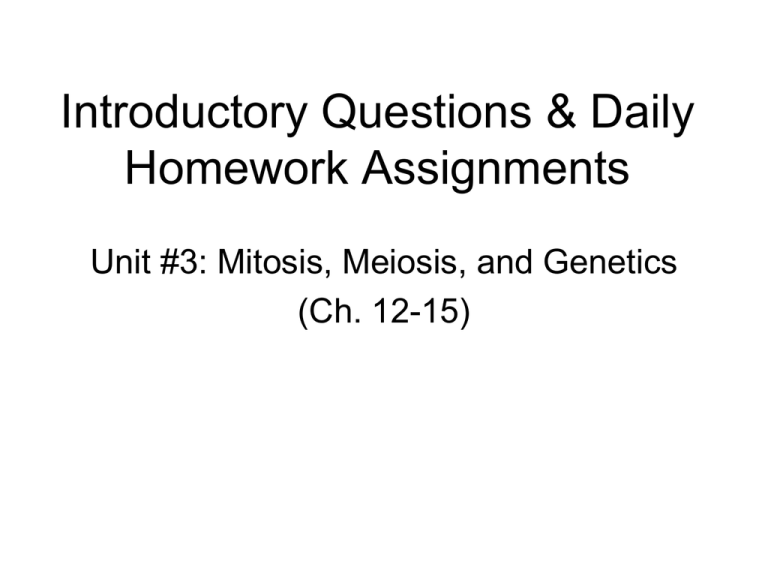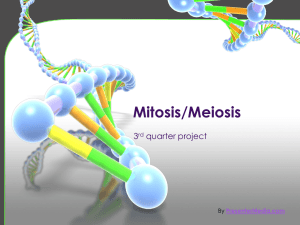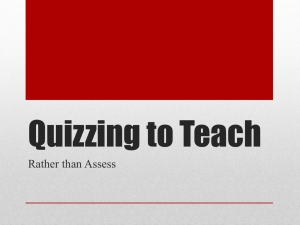
Introductory Questions & Daily
Homework Assignments
Unit #3: Mitosis, Meiosis, and Genetics
(Ch. 12-15)
Introductory Questions
Introductory Questions #1
1) How much DNA does a typical human cell have?
How are chromosomes differ from chromatin?
2) How is a somatic cell different from a gamete?
3) How is every species different in regards to their
chromosomes?
4) Name the main stages of the cell cycle. (pg. 221)
5) What are the four stages of mitosis? Which stage
is the longest and which stage is the shortest?
6) Give three specific events that occur during
prophase. How is Prometaphase different from
prophase?
7) How are plant cell different from animal cells when
they divide?
Introductory Questions #2
1) What are the three checkpoints of the cell cycle that
regulates mitosis? Which one is considered the “restriction
point”? Why this checkpoint and not the others?
2) Name the two protein molecules that are high in
concentration during the mitotic (M) phase of the cell cycle.
Name the complex that it forms.
3) Why are telomeres considered to be a “mitotic clock”? DO
telomeres contain genes? What does telomerase do?
(see pgs 306-307 in Ch. 16)
4) How are tumor suppressor genes different from an
oncogenes? How is a proto-oncogene different from an
oncogene? What kind of a protein does the RAS gene
produce?
5) What is the difference between a malignant tumor and a
benign tumor?
6) When looking at the hypothetical sequence of how mitosis
may have evolved how is the process different in a
bacteria and diatom from a plant and animal cell?
Introductory Questions #3
1)
2)
3)
4)
5)
6)
7)
How is a totipotent stem cell different from a pluripotent stem
cell? See pgs. 415-418 (Ch. 21)
Which phase is used to obtain pictures of chromosomes in
order to generate a karyotype
Give five differences between Mitosis and Meiosis.
Name three factors in Meiosis & reproduction that
contributes in increasing genetic variability within a
population.
What is a polar body? How is oogenesis different from
spematogenesis?
How is a sporophyte different from a gametophyte? What do
they produce and what process is involved, mitosis or
meiosis?
What is a tetrad? Which phase of Meiosis does crossing over
occur?
Introductory Questions #4
Traits:
Flower Position:
Axial
& terminal
Seed Color:
Yellow & green
Height:
Tall
& short
1) Monohybrid cross: Two hybrid plants are tall.
How many of the offspring would you predict will
be short if there were 400 produced?
2) Dihybrid cross: Two hybrid plants with yellow
seeds and axial flowers are crossed. How many
of the offspring would you predict will have axial
flowers with green seeds if 3750 are produced?
3) Trihybrid cross: Both parents are heterozygous
for all three traits. How many will be tall with
terminal flowers and yellow seeds if 250 are
produced?
Introductory Questions #5
1)
A Monohybrid cross and Dihybrid cross always
produces Phenotypic rations of 3:1 and 9:3:3:1. What
phenotypic ratio will produced from a trihybrid cross?
2) Solve this trihybrid cross with Pea plants
Traits: Seed color, seed shape, height
Male
Heterozygous all traits
Female
Heterozygous yellow and tall plant
w/ wrinkled seeds
a) How many offspring out of 500 would you predict will
be Tall with wrinkled, yellow seeds?
b) How many offspring of the 500 will have green seeds
that are round and tall?
Introductory Questions #6
1) How is co-dominance different from Incomplete
dominance? Give an example of both.
2) Give an example of polygenic inheritance.
3) Name three autosomal disorders that are
dominant and three that are recessive. (see table)
4) Briefly explain what epistasis is. Do the
phenotypic ratios follow the 9:3:3:1 we ususally
see in a dihybrid cross?
5) Name the person who determined that genetic
traits can be linked and inherited together?
6) What does it mean when traits are sex linked?
Give an example of a human sex linked trait.
How can linked traits be separated?
7) What is a two point test cross? Why would you
use one?
Introductory Questions #7
1)
2)
A female heterozygous for Seed shape and color
is crossed with a male that is heterozygous for
seed shape but homozygous recessive for seed
color. How many offspring would you predict
(expect) to be yellow and wrinkled if 500 were
produced?
If only 50 offspring were yellow and wrinkled how
can you tell if your results were only due to
chance? What statistical test could you do in
order to determine if there’s a significant
difference between what you actually got (50) vs.
what you expected? (Round your answers up on
this one. Here are the observed results of all 500
plants.
201 round & yellow
204 round & green
45 wrinkled and green
50 wrinkled & yellow
IQ #7 - Answers
**The Genetic Cross: RrYy x Rryy
How many will be yellow and wrinkled? (500)
Poss. genotypes: Yyrr = 1/2 x 1/4 = 1/8
Answer: 1/8 x 500 = 62.5 are expected to be yellow,
green
Do a chi-squared test
Chi-Square value: ????
Expected Values for each phenotype:
187.5,187.5, 62.5, 62.5
Chi-squared value:
Critical value from table (in lab)
7.82
(0.05 or 95%)
IQ#7: Question #2 (cont’d)
• Expected (calculated Values)
Expect. Value
wrinkled & green
Round & yellow
Round & green
Wrinkled & Yellow
62.5
187.5
187.5
62.5
Obs. value
45
201
204
50
Answers to #7
2 = (O – E)2
E
2 =
2 =
(45 – 62.5)2 + (201-187.5)2 + (204 – 187.5)2 +
62.5
187.5
187.5
4.9
+ 0.972
+
1.452
+
(50-62.5)2 = 9.824
62.5
2.5
= 9.824
Critical Value: 4 groups = 3 degrees of freedom= 7.81
9.824 is greater than 7.81 therefore we reject the null hypothesis
What does this mean?
Introductory Questions #8
1) When gene loci are close in proximity (linked) on
the chromosome, will you see more or less
recombinants possessing these traits?
2) What happens when non-disjunction occurs
during meiosis? What is the result of this error?
(see pg. 285)
3) Name the four types of chromosomal mutations
that lead to genetic disorders. Which two are
most likely to occur during meiosis? (pg. 287)
4) The “cri du chat” syndrome is caused by which of
the four chromosome abnormalities? Which
chromosome number is affected?
Homework Mon. 10/15
-Read Chap. 12 (sect. 12.1-12.2) – Pgs. 218-228
-Print out Study Guide for Ch. 12-15 (optional)
-Print out power point Pres. For Ch. 12 (optional)
Homework Tues. 10/16
I. Lab Extension Investigation write up:
-Research Question
-Hypothesis (w/reasoning)
-Variables (dependent/independent)
<or> expt. Group vs. Control group
-Variables you need to control
II. Review/Read Chap. 12 (sect. 12.1-12.2) -Pgs. 218-228
III. Do IQ #1 (work on study guide for Ch. 12)
**Reading Quiz tomorrow**
Homework Wed. 10/17
I. Lab Extension Investigation write up:
-Review your RQ, Hypoth, Variables, & Controls
-Make a list of Materials you’ll need (be specific)
-Write a general procedure (noting the controls)
-Design a Data table for collecting data
DUE: Mon. 10/22
II. Review/Read Chap. 12 (sect. 12.3)
III. Do IQ #2 (work on study guide for Ch. 12)
Homework Thurs. 10/18
I.
Go to the Annenberg website and watch the video and
finish watching the “Cell Biology & Cancer” at:
http://www.learner.org/resources/series187.html
-Scroll down & Find “ Session 8: Cell Biology & Cancer
-Click on “VoD” and watch
**Be sure to have your 10 Key statements written along with
all questions answered.
You will turn into the Substitute tomorrow.
Homework Fri. 10/19
I. Lab Extension Investigation write up:
-Review your RQ, Hypoth, Variables, & Controls
-Make a list of Materials you’ll need (be specific)
-Write a general procedure (noting the controls)
-Design a Data table for collecting data
DUE: Mon. 10/22
II. Do the FOUR Activities from the textbook website for
Concepts 12.1 - 12.3 and the Investigation.
Overview - Activity: Roles of Cell Division
Concept 12.1 Cell division results in genetically identical daughter cells
Concept 12.2 The mitotic phase alternates with interphase in the cell cycle
Activity: The Cell Cycle
Activity: Mitosis and Cytokinesis Animation
Activity: Mitosis and Cytokinesis Video
Investigation: How Much Time Do Cells Spend in Each Phase of Mitosis?
Concept 12.3 The cell cycle is regulated by a molecular control system
Activity: Causes of Cancer
Homework Mon. 10/22
I.
Lab #4 – Go to the Online website: Lab Bench
http://www.phschool.com/science/biology_place/labbench/
-Do Questions #1-19
-Printout the Quiz and attach.
II. Read Pgs. 228-233 (sect. 12.3) & Pg. 370-374 (19.3)
III. IQ #2-answer all the questions
Homework Tues. 10/23
I.
Finish Online Pre-Lab for Mitosis & Meiosis
**Be sure to printout the Self Quiz for Meiosis (6 quest.)
II. Do the Activity Quiz & Chapter Quiz for Ch. 12 – Submit
both by midnight tonight.
Homework Wed. 10/24
I.
Read Chapter 13 (Sect. 13.1-13.2) – possible
reading quiz on Thurs.
II. Students that were not present for the essay
prompts will have to come in during a lunch
period, 6th period, or after school and make up the
prompts (20 min. per prompt) on Thursday &
Friday.
III. Work on the Study Guide for Chapter 13.
(optional)
-Answer the interactive Questions
-Answer the Multiple choice questions
Homework Thurs. 10/25
I.
Do the Activity Quiz & Chap. Quiz for Chapter 13
-Submit by midnight tonight
II. Work on your Lab Extension Investigation
-Be sure that your procedure is allowing you to
obtain good data.
-Have some data written into your data table
**Must turn in some preliminary data by Mon. 10/29
Homework Fri. 10/26
I.
Finish Lab #4 - Drawings and labeling your images and
drawing. A minimum of two phases shown in Mitosis &
interphase. Labels include:
-chromosomes, spindle apparatus, cell membrane,
-chromatin fibers, nuclear membrane
**Answer the FIVE Analysis Questions on a Separate sheet
of paper.
II. Read Ch. 14 (14.1-14.2) “Mendelian Genetics”
**Option: work on the study guide questions for Ch. 14
(pgs. 251-260)
III. Continue to work on your Lab Extension Investigation
-Be sure that your procedure is allowing you to obtain
good data.
-Have some data written into your data table
**Must turn in some preliminary data by Mon. 10/29
Homework Mon. 10/29
I.
Finish Lab #4 - Drawings and labeling your images and
drawing. A minimum of two phases shown in Mitosis &
interphase. Labels include:
-chromosomes, spindle apparatus, cell membrane,
-chromatin fibers, nuclear membrane
**Answer the FIVE Analysis Questions on a Separate sheet
of paper. DUE Tomorrow
II. Read Ch. 14 (14.1-14.2) “Mendelian Genetics”
**Option: work on the study guide questions for Ch. 14
(pgs. 251-260)
III. Do IQ #4
**LAB EXTENSION INVESTIGATION
All Data collected by Wed. Nov. 7th
Homework Tues. 10/30
I. Do Genetic problems #1-4 on A Separate sheet of
paper. BE sure to show all work for full credit.
II. Finish IQ #5
III. Continue work on your Lab Extension. I will be
available tomorrow & Friday during 6th period &
after school.
**LAB EXTENSION INVESTIGATION
All Data collected by Wed. Nov. 7th
Homework Wed. 10/31
I. Continue working on Genetic problems #5 - 8 on a
Separate sheet of paper. BE sure to show all work for
full credit.
II. Go to the Textbook website and do the FOUR
activities for concepts 14.1 - 14.3
Homework Thurs. 11/1
I. Finish working on Genetic problems #9 - 14 on a
Separate sheet of paper. BE sure to show all work
for full credit.
II. Do the Online Activity Quiz & Chap. Quiz for
Chapter 14. Submit your answers.
III. Prepare/review for Formal quiz #2
(35 Quest.) on Ch. 12 – 14.
Homework Fri. 11/2
I. Go to My Big Campus and use the KEY to
grade/correct your answers to the Genetic
Problems (#1-14) – Use a RED PEN for your
corrections
II. Read Chapter 15 “Chromosomal Theory of
Inheritance” Sect. 15.1-15.2 (pgs. 274-281)
III. Work on the Study Guide for Chapter 15
(optional)
Homework Mon. 11/5
I.
Do the Pre-Lab for “Genetics of Drosophila”
-Printout & Attach the quiz to your pre-Lab. Go to
this website & choose “Lab 7”
http://www.phschool.com/science/biology_place/l
abbench/
II. Review Chapter 15 “Chromosomal Theory of
Inheritance” Sect. 15.1-15.2 (pgs. 274-281)
**Reading Quiz Tomorrow**
III. Continue working on the Study Guide for Chapter 15
(optional)
Homework Tues. 11/6
I.
Complete Lab #5-Naswer all the questions and
show your work for the Chi-square analysis
http://www.phschool.com/science/biology_place/l
abbench/
II. Read Chapter 15 Sect. 15.2-15.4 (pgs. 282-288)
**Reading Quiz Tomorrow**
III. Continue working on the Study Guide for Chapter 15
(optional)
Homework Wed. 11/7
I.
Do the Activity Quiz and the Chapter Quiz for Ch. 15
online and submit your answers.
II. Complete Chapter 15 Study Guide (optional)
III. Begin Analyzing your data for your Lab Extension
**I will be here until 4:30 for you to collect data**
Homework Thurs. 11/8
I.
Do the Cumulative Test for Ch. 12-15 for Ch. 15
online and submit your answers and print out your
results. (Attach to your Assignment Packet)
II. Use the Key for Chapter 15 Study Guide and correct
your answers. (optional) – Go to My big campus
website or the Troy High Website (find my webpage)
III. Review All IQ’s, Labs, and Videos from this unit.
Assignment Packet – Ch. 12-15
•
•
•
•
•
•
•
•
Cover Sheet: Name, Period, & Chapters
Pre-Lab – Mitosis & Meiosis
Pre-Lab – Genetics of Drosophila
Cancer Video Notes (stream online @ home)
Video “Generations” (w/sub)
Genetic Problems (x14) –ALL WORK SHOWN
IQ’s (x8)
Cumulative Test Online Textbook site-Printout
results (40 Quest. For Ch. 12-15)
Breakdown of Test #2 (Ch. 12-15) “Genetics”
•
•
•
•
•
Chapter 12 Mitosis (CdK, Cyclin, & Cancer)
Chapter 13 Meiosis
Chapter 14 Mendelian Genetics
Chapter 15 Chromosome Theory
Labs:
8 Quest.
12 Quest.
21 Quest.
16 Quest.
6 Quest.
– Mitosis & Meiosis
– Genetics of Drosophila (3)
• Cumulative Questions:
–
–
–
–
–
–
–
12 Quest.
Cell Membrane
DNA
Solutions & Osmosis
Cell respiration & Electron flow
Cell organelles
Properties of water
Glycolysis ------Krebs
Total Questions
75 Questions
Table of Disorders
Name
Chromosome
Cellular effect
Overall
involvement or (#)
Phenotypic Result
_______________________________________________________________________________
Down Syndrome
Auto (47)
Many
Kleinfelter’s Syndrome
Sex (47)
Turner’s Syndrome
Sex (45)
Cri du Chat
Auto/Deletion #5
Fragile X
Auto & Sex
Phenylketonuria (PKU)
Auto rec.
Enzyme def.
Alkaptonuria
Auto rec.
Enzyme def.
Sickle Cell Anemia
Auto rec.
Hemoglobin Struct.
Cystic Fibrosis
Auto rec.
Tay Sachs
Auto rec.
Huntington’s Disorder
Auto Dom.
Achondroplasia
Auto Dom.
Albinism
Auto rec.
Color Blindness
Sex-linked
Muscular Dystrophy
Sex-linked
Hemophlia
Sex-linked
Alzheimer’s
Auto Dom.
Hypercholesterolemia
Auto Dom.
Lab Extension Timeline/Due Dates
1.
Research Question (clear focused)
Hypothesis (predictive statement)
Variables (independent & dependent)
ID all controls for your investigation.
-DUE: Wed. 10/17 (before I leave)
2. Materials/Equipment of Lab set up
Sample data table (w/title, units, uncertainty)
Well thought out Procedure.
-DUE: Mon. 10/22
3. Trial runs of your experiment (preliminary data)
-DUE: Thurs. 10/25 (class avail. Mon. & Wed. until 4:30)
****Extended to Monday 10/29***
4. Collect data for Multiple Trials (min. 5)
**All Data collected by Wed. Nov. 7th
5. Analysis & Conclusion of Data (Full Report) – DUE: Wed. Nov. 14th
**You will have to turn in TWO copies of your report on Nov. 14th.
**One with IB student’s name only & the other with Both Names







